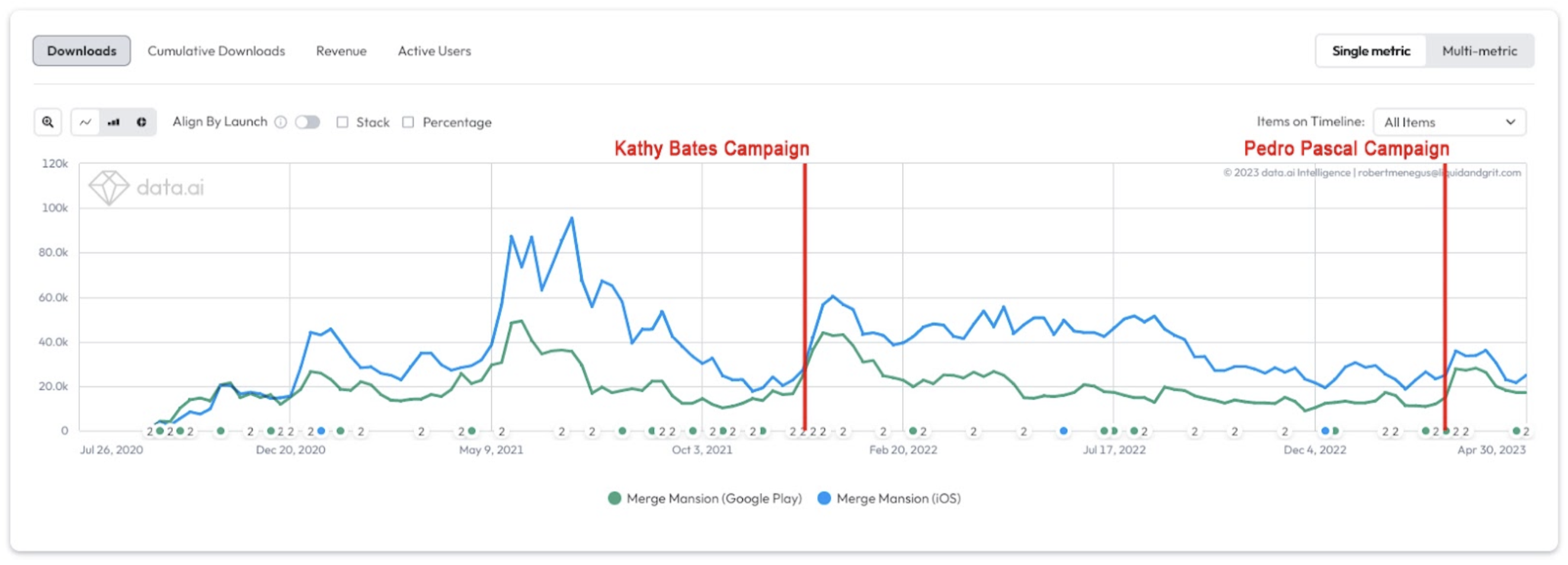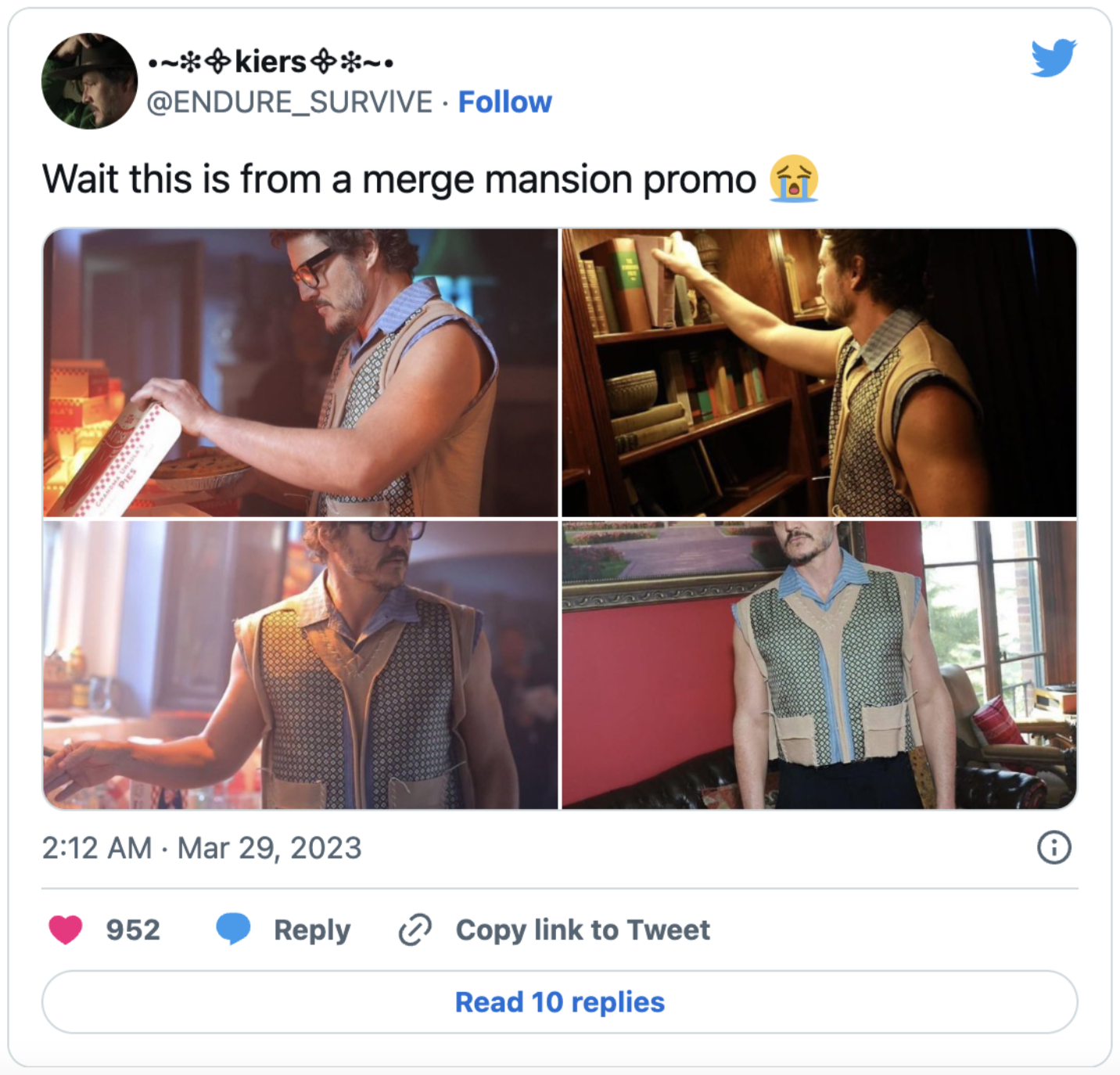Merge Mansion seized on the success of a series of animated ads by creating a big-budget live-action campaign starring the famous actress Kathy Bates. These ads went viral by embracing an absurd premise that was popular with fans, helping to boost downloads by 180K per month for over six months.
In anticipation of a major app update, a follow-up campaign starred Pedro Pascal in a series of short films and an elaborate live event. Although this second campaign attracted a lot of attention, it produced a fraction of the downloads of the first campaign, suggesting that virality may be a better strategy for new apps or audiences.
The Campaigns and Impacts
Merge Mansion’s ads first gained traction in 2021 as a result of its animated ads featuring a sinister grandma, which developed a cult following online. After the ad campaign’s initial success, the app partnered with the actress Kathy Bates to play the grandmother in four live-action commercials that aired beginning in December 2021.
The Kathy Bates ads were created by Wieden + Kennedy and ran during prime broadcasting hours, including during the Bachelorette. These ads went viral on social media due to their weird narrative, high-quality production, and unexpected celebrity star.
During the Kathy Bates campaign, Merge Mansion’s iOS U.S. downloads increased by roughly 100K per month and sustained this increase for about eight months. These ads are no longer live on Merge Mansion’s YouTube page, so we can’t say what kind of viewership they attracted online.
In March 2023, Merge Mansion ran a follow-up campaign with Pedro Pascal that started with three online short films. The campaign culminated in an immersive live event during which Pascal, Jesse Williams, Ashley Benson, and a mix of YouTubers, reality stars, press, fans, and VIPs explored a hotel decorated to look like the app’s mansion. The interactive event included live theater and escape room-inspired activities. A video of the event was released on May 10th.
The three short videos with Pedro Pascal have over 25M views on YouTube, but the campaign has only produced a 44K increase in monthly US iOS downloads. Although the campaign may still be ongoing, downloads have mostly returned to their baseline after just one month.
Understanding Virality
Virality is a great strategy for building an audience, but it may have diminishing returns once a brand has a large audience. Merge Mansion went bigger, weirder, and likely more expensive with their Pedro Pascal campaign, but it has so far produced a fraction of the download growth of the Kathy Bates campaign. When it comes to viral content, it’s hard to make the same approach work twice because fans quickly come to expect things that may initially have been surprising or exciting.
Several other factors may have contributed to the lower impact of the Pascal campaign. Unlike the Bates campaign, the Pascal campaign did not include TV ads, so it may have a smaller reach. Likewise, Pascal is popular with a younger audience than Bates, and that audience may be more difficult to convert. Lastly, Merge Mansion may have captured so much of its target audience during the Kathy Bates campaign that there simply weren’t that many new users left to draw in with this style of viral advertising.
Virality is hard to engineer; apps can reduce risks by finding low-cost ways to build audiences’ connections with a character before investing in big-budget campaigns. The sinister grandma was already popular online before the Kathy Bates campaign, so Merge Mansion had a strong reason to think the campaign would be popular with audiences. In contrast, Pedro Pascal’s detective is a brand new character that may not feel as connected to the Merge Mansion universe or playerbase.
Growing ad campaigns out of characters and plotlines that already have a following has the added benefit of making fans feel like they’re in on the joke and gives them a stake in the success of campaigns, which can further contribute to virality.
Ad Creatives and User Acquisition
Even though the ads are only tangentially related to Merge Mansion, they appeal to audiences who are interested in character-driven stories—a key component of Merge Mansion. The ads don’t include anything resembling the app’s gameplay, and the sinister granny storyline isn’t actually part of the app’s narrative. But audiences who are attracted to the episodic narrative of the ads may also be interested in the episodic stories offered by Merge Mansion, and both the app and the ads focus on characters with big personalities.
Using ads that echo your app’s main selling point is an effective approach to top-of-the-funnel marketing in a post-ATT world. In the past, apps were able to use fine-grained data to target users who were likely to download and retain, even if the content of ads was completely unrelated to the app itself. This is the reason for the glut of mobile gaming ads that show fake gameplay or images.
Now, apps no longer have access to the individualized data that made those fake or misleading ads so successful. Instead, apps should develop ad creatives that align with the core appeal of their gameplay, whether that’s character-driven stories like Merge Mansion, the power fantasies of an RPG, or the excitement of a casino app. These ads don’t need to sell your app’s gameplay but should sell the kind of experience your app offers.



